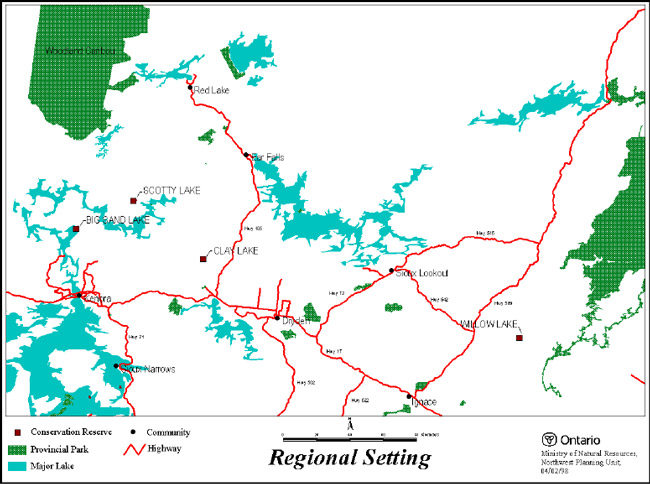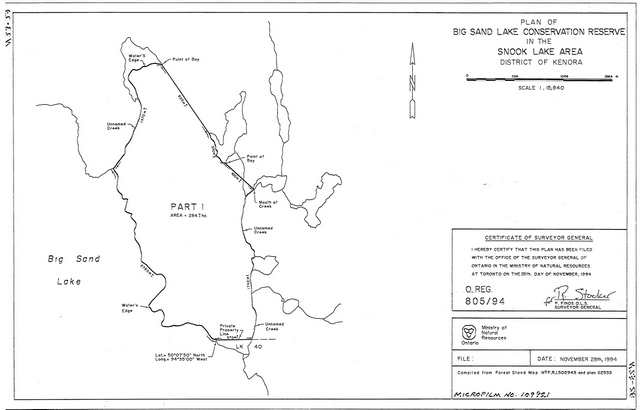Big Sand Lake Conservation Reserve Management Statement
This document provides policy direction for the protection, development and management of the Big Sand Lake Conservation Reserve and its resources.
Statement of Conservation Interest
English River, Kenora District
July, 1998
Updated April 7, 2011
Next examination due December 31, 2020
Approval statement
I am pleased to approve this Statement of Conservation Interest for the Big Sand Lake Conservation Reserve.
This Statement of Conservation Interest provides guidance for the management of the conservation reserve and the basis for the ongoing monitoring activities. More detailed direction at this time is not anticipated. Should significant facility development be considered or complex issues arise requiring additional studies, more defined management direction, or special protection measures, a more detailed Conservation Reserve Management Plan will be prepared with full public consultation.
The public was widely consulted during the original regulation process and further consultation is not required at this time.
The conservation reserve will be managed under the jurisdiction of the Kenora West Area Supervisor, Kenora District, Ministry of Natural Resources.
M.L. Willick
Regional Director
Northwest Region
Examination and adjustment history of management direction
Table of adjustment history of management direction
| Approval date | Examination or type of adjustment | Examination outcome | List of supporting documents |
|---|---|---|---|
|
May 24, 2011 |
Examination |
Administrative Update |
|
1.0 Background information
Big Sand Lake Conservation Reserve contributes to achieving the objectives of Ontario’s Provincial Parks and Conservation Reserves Act, 2006 including ‘to permanently protect representative ecosystems, biodiversity, and provincially significant elements of Ontario’s natural and cultural heritage’ and ‘to provide opportunities for ecologically sustainable land uses.
The purpose of this document is to identify the natural heritage values of Big Sand Lake Conservation Reserve, the activities which occur there and through a set of management guidelines, lay out the activities which will be permitted and not permitted and the direction of management for the area. For more information for the basis of this Statement please refer to the "Conservation Reserves Policy and Procedure PL3.03.05", specifically pages 2–6 and 14–22 of the of the procedure.
Background information
| Name | Big Sand Conservation Reserve |
|---|---|
| Site region / Site district | 4S–1 |
| OMNR administrative region / District / area | Northwest / Kenora / English River Area |
| Total area (ha) | 284 |
| Regulation date | January 7th, 1995 |
| First Nations | Wabaseemoong Independent Nations; Treaty 3 |
| OBM | 2015380055500 |
| Latitude / Longitude | 50 08’ / 94 35’ |
| Basemap | 502943 |
| FRI Stands | 400,401,398,402,431,399,337,430,432 |
| General location description | Located on the northeast shore of Big Sand Lake, 40 km north of Kenora |
| Access | The area is isolated and only accessible by boat or float plane |
Targets
This section provides a summary of the earth and life science values and cultural resources represented and recreational opportunities available or possible.
| Life science representation | Old growth red and white pine One critical landform-vegetation type is represented within Big Sand Lake Conservation Reserve. |
|---|---|
| Earth science representation | Weakly broken bedrock; weakly broken ground moraine |
| Cultural resource representation | No documented cultural resources |
| Recreational opportunities | Opportunities exist for wildlife viewing, hunting tourism and sport fishing on adjacent waters |
Survey information
This section provides an overview of the inventories completed, their level of detail and any further inventories that are needed.
| Survey level | Life science | Earth science | Cultural | Recreational | Other |
|---|---|---|---|---|---|
| Reconnaissance | Yes – ground and aerial surveys completed in 1994 | No | No | No | No |
| Detailed | No | No | No | No | No |
| Requirement | No | No | No | No | No |
2.0 Values to be protected
This section provides a description of the key natural heritage values on the site and their condition relative to past resource use and management activities and their sensitivity to future land use and management activities.
Values identified on the site
| Life science | Old growth red and white pine community at northern fringe of this forest community’s northern range; core area of 11 ha has 40%–60% red pine 156 years old; other stands contain up to 60% white pine and scattered red pine. Other notable species recorded in the conservation reserve include Smith’s Club-rush (S3), Vasey’s Rush (S3) and Bald Eagle (Special Concern). Refer to the Life Science Checksheet for a more comprehensive description of life science values within the reserve. |
|---|---|
| Earth science | Weakly broken bedrock; weakly broken ground moraine |
| Cultural | None identified |
| Aboriginal | None identified |
| Tourism | No specific site values; area is located on an active tourism oriented water system, public beach adjacent to the south boundary of the Reserve |
| Recreational fishing | High profile recreational fishery in adjacent waters |
| Recreational hunting | Unknown (likely low); part of a bear management area agreement |
| Mining | Low to moderate mineral potential; no significant site concerns (MNDMF, Kenora) |
| Aggregate | None on site |
| Forest harvest | High value timber of significant volume; unallocated within Kenora Management Unit FMP and large portion is contained within a shoreline and skyline AOC Part of a trapline registered to a First Nation Trapper |
| Trapping | Part of a registered trapline to a First Nation Trapper |
| Commercial fsh | The area forms part of a commercial baitfishing block |
Values to be protected
The intent of this Statement is to protect these values by establishing management guidelines for existing and potential uses in this area given the level of past disturbance and the nature of the existing features.
Forest values – the forest in the entire area is to be protected (including the old growth component) from any alteration; forest type will naturally maintain itself for at least another 50–100 years. It may be a source for genetic material for northern red and white pine genotypes.
Recreational Values – sport fishing and hunting opportunities.
Tourism Values – the contribution of this unique and highly attractive area to local tourism.
3.0 Management guidelines
The following topics briefly indicate the existing situation followed by the management guidelines to be implemented or continued.
Land tenure
The Big Sand Lake Conservation Reserve consists entirely of Crown land; No disposition, by sale or Crown Lease or Land Use Permit, will occur within the reserve. The Water Power Lease which regulates flooding to a specified level will remain in effect. It should be noted that the Water Power Lease does not affect the values being protected.
Existing and proposed development
No development exists in the area; no development will be allowed in the area that would disturb the forest including its understory.
Recreational activities
Sport fishing is allowed in adjacent waters; no sport fishing presently occurs in the area itself (no fishable water).
Sport hunting will continue in the area.
Activities such as snowmobiling and the use of all–terrain vehicles will generally be permitted to continue on existing trails only where they do not adversely affect the values being protected. No new trails will be permitted.
Commercial activities
- The area forms part of a First Nations Trapline; trapping will continue as a permitted activity
- The area is presently part of a bear management area; no change is required at this time
- No other commercial activities exist in the area; no new ones will be permitted ie. road construction, aggregates, utility corridors
- The area will be permanently removed from the Kenora Management Unit FMP allocation and an examination of the possible impact of activities on adjacent lands should be evaluated in the FMP and any required changes to the FMP made to protect the existing values
- The area has been withdrawn from all mining exploration and extraction activities by the Ministry of Northern Development and Mines and Forestry at MNR’s request
Aboriginal interests
The Conservation Reserve is located within the Wabaseemoong Independent Nations Traditional Land Use Area. The First Nation was consulted and did not express concern about the creation of the Reserve; nothing in this Statement of Conservation Interest affects in any way existing or future aboriginal or treaty rights.
Natural resources stewardship
Vegetation management
The area will naturally evolve and should be stable for some 50–100 years.
As this conservation reserve is currently surrounded by high timber values of the Kenora Forest Unit (formerly Kenora Crown Unit), it will remain as part of the MNR’s boreal zone within the Forest Fire Management Strategy for Ontario (OMNR 2004). All fires having the potential to negatively impact values and/or cause social disruption will receive Full Response and sustained action until extinguished.
There is a concern that this strategy may be in conflict with the ecosystem management objective for old growth values (biodiversity, genetic heritage) where low intensity wildfire would contribute to ecological maintenance and renewal within this conservation reserve. However, the small size of this conservation reserve and the extremely high adjacent values rule out allowing a natural fire regime replaces.
Fish and wildlife management
Nothing required other than existing WMU and sport fishing regulation and management activities.
Landforms
No requirements except continued protection.
Cultural resources stewardship
No requirements at this time based on existing information.
Client services
Make information about this conservation reserve available. Ensure all resource users especially forestry and mining companies, are aware of its location and permitted uses.
Research
Non–destructive research related to the study of old growth white pine communities will be encouraged in this conservation reserve.
Marketing
No requirements at this time.
4.0 Implementation
These management guidelines will be implemented immediately by Kenora District. Any MNR Resource Management Plans or Land Use Plans which include this area will be amended accordingly. Any affected clients will be immediately informed of amendments to this management direction. Administrative responsibility for the conservation reserve rests with the Planning and Information Management Supervisor. Implementation will primarily involve monitoring activities to ensure adherence to the management guidelines.
5.0 Review and revisions
Review and revisions
Methods of reviewing management direction will be consistent with the Protected Areas Planning Manual (OMNR 2009) and its associated guidelines. In accordance with the Provincial Parks and Conservation Reserves Act, 2006, MNR will annually examine management direction documents that have been in place for ten years or more. The next scheduled examination for Big Sand Lake Conservation Reserve will be in 2020.
Public consultation
Results of past consultation
Under the previous Keep It Wild Initiative, contact was made with First Nations, the timber companies and local communities in June, 1994. Newspaper advertisements and a district information package was distributed in August, 1994. No concerns were identified with respect to the establishment of this reserve.
Present and future consultation
More widespread consultation is not deemed necessary at this time because of the extensive consultation which occurred in 1994 (see section 5.2.1).
6.0 Author
This Statement of Conservation Interest was prepared by Gerry Wells, Senior Lands and Waters Technician, Kenora District.
7.0 References
Ontario Ministry of Natural Resources. 1997. Conservation Reserves Policy and Procedure. PL3.03.05. Ministry of Natural Resources. Conservation Reserves Policy and Procedure. PL 3.03.05. 1997
Ontario Ministry of Natural Resources. 2004. Forest Fire Management Strategy for Ontario.
Queen’s Printer for Ontario, Toronto. 64 pp.
Ontario Ministry of Natural Resources. 2009. Ontario Protected Areas Planning Manual. Peterborough. Queen’s Printer for Ontario. 50 pp.
Provincial Parks and Conservation Reserves Act. 2006. Toronto. 44 pp. [online]
Figure 1: Big Sand Lake Conservation Reserve Regional Setting

Figure 2: Big Sand Lake Conservation Reserve Boundary

Enlarge Figure 2: Big Sand Lake Conservation Reserve Boundary